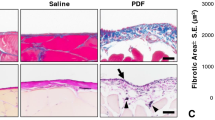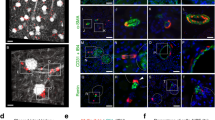Abstract
Peritoneal fibrosis is one of the most common morphological changes observed in continuous ambulatory peritoneal dialysis (CAPD) patients. Both resident fibroblasts and new fibroblast-like cells derived from the mesothelium by epithelial-to-mesenchymal transition are the main cells involved fibrogenesis. In order to establish markers of peritoneal impairment and pathogenic clues to explain the fibrogenic process, we conducted an immunohistochemical study focused on peritoneal fibroblasts. Parietal peritoneal biopsies were collected from four patient groups: normal controls (n=15), non-CAPD uremic patients (n=17), uremic patients on CAPD (n=27) and non-renal patients with inguinal hernia (n=12). To study myofibroblastic conversion of mesothelial cells, α-smooth muscle actin (SMA), desmin, cytokeratins and E-cadherin were analyzed. The expression of CD34 by fibroblasts was also analyzed. Fibroblasts from controls and non-CAPD uremic patients showed expression of CD34, but no myofibroblastic or mesothelial markers. The opposite pattern was present during CAPD-related fibrosis. Expression of cytokeratins and E-cadherin by fibroblast-like cells and α-SMA by mesothelial and stromal cells supports that mesothelial-to-myofibroblast transition occurs during CAPD. Loss of CD34 expression correlated with the degree of peritoneal fibrosis. The immunophenotype of fibroblasts varies during the progression of fibrosis. Myofibroblasts seem to derive from both activation of resident fibroblasts and local conversion of mesothelial cells.




Similar content being viewed by others
References
Abe R, Donnelly SC, Peng T et al (2001) Peripheral blood fibrocytes: differentiation pathway and migration to wound sites. J Immunol 166:7556–7562
Aiba S, Tagami H (1997) Inverse correlation between CD34 expression and proline-4-hydroxylase immunoreactivity on spindle cells noted in hypertrophic scars and keloids. J Cutan Pathol 24:65–69
Aiba S, Tabata N, Ohtani H et al (1994) CD34+ spindle shaped cells selectively disappear from the skin lesions of scleroderma. Arch Dermatol 130:593–597
Barth PJ, Ebrahimsade S, Hellinger A et al (2002) CD34+ fibrocytes in neoplastic and inflammatory pancreatic lesions. Virchows Arch 440:128–133
Bongiovanni M, Viberti L, Pecchioni C et al (2002) Steroid hormone receptor in pleural solitary fibrous tumours and CD34+ progenitor stromal cells. J Pathol 198:252–257
Bucala R, Spiegel LA, Chesney J et al (1994) Circulating fibrocytes define a new leukocyte subpopulation that mediates tissue repair. Mol Med 1:71–81
Chauhan H, Abraham A, Phillips JR et al (2003) There is more than one kind of myofibroblast: analysis of CD34 expression in benign, in situ, and invasive breast lesions. J Clin Pathol 56:271–276
Delia D, Lampugnani MG, Resnatti M, Dejana E, Aiello A, Fontanella E, Soligo D, Pierotti MA, Greaves MF (1993) CD34 expression is regulated reciprocally with adhesion molecules in vascular endothelial cells in vitro. Blood 81:1001–1008
Dobbie JW (1992) Pathogenesis of peritoneal fibrosing syndromes (sclerosing peritonitis) in peritoneal dialysis. Perit Dial Int 12:14–27
Iwano M, Plieth D, Danoff TM et al (2002) Evidence that fibroblasts derive from epithelium during tissue fibrosis. J Clin Invest 110:341–350
Kirchmann TT, Prieto VG, Smoller BR (1995) Use of CD34 in assessing the relationship between stroma and tumor in desmoplastic keratinocytic neolasms. J Cutan Pathol 22:422–426
Krause DS, Fackler MJ, Civin CI (1996) CD34: structure, biology and clinical utility. Blood 87:1–13
Mateijsen MAM, van der Wal AC, Hendriks PMEM et al (1999) Vascular and interstitial changes in the peritoneum of CAPD patients with peritoneal sclerosis. Perit Dial Int 19:517–525
Nakayama H, Enzan H, Miyazaki E et al (2000) Differential expression of CD34 in normal colorectal tissue, peritumoral inflammatory tissue, and tumor stroma. J Clin Pathol 53:626–629
Nakazato Y, Yamaji Y, Oshima N et al (2002) Calcification and osteopontin localization in the peritoneum of patients on long-term continuous ambulatory peritoneal dialysis therapy. Nephrol Dial Transplant 17:1293–1303
Narvaez D, Kanitakis J, Faure M et al (1996) Immunohistochemical study of CD34-positive dendritic cells of human dermis. Am J Dermatopathol 18:283–288
Oldfield MD, Bach LA, Forbes JM et al (2001) Advanced glycation end products cause epithelial-myofibroblast transdifferentiation via the receptor for advanced glycation end products (RAGE). J Clin Invest 108:1853–1863
Plum J, Hermann S, Fusshöller A et al (2001) Peritoneal sclerosis in peritoneal dialysis patients related to dialysis settings and peritoneal transport properties. Kidney Int 59[Suppl 78]:42–47
Powell DW, Mifflin RC, Valentich JD et al (1999) Myofibroblasts. I. Paracrine cells important in health and disease. Am J Physiol 277:C1–C19
Schürch W, Seemayer TA, Gabbiani G (1998) The myofibroblast. A quarter century after its discovery. Am J Surg Pathol 22:141–147
Selgas R, Fernandez-Reyes MJ, Bosque E et al (1994) Functional longevity of the human peritoneum: how long is continuous peritoneal dialysis possible? Results of a prospective medium–long term study. Am J Kidney Dis 23:64–73
Shioshita K, Miyazaki M, Ozono Y et al (2000) Expression of heat shock proteins 47 and 70 in the peritoneum of patients on continuous ambulatory peritoneal dialysis. Kidney Int 57:619–631
Skobieranda K, Helm KF (1995) Decreased expression of the human progenitor cell antigen (CD34) in morphea. Am J Dermatopathol 17:471–475
Stahl PJ, Felsen D (2001) Transforming growth factor-β, basement membrane, and epithelial-mesenchymal transdifferentiation. Implications for fibrosis in kidney disease. Am J Pathol 159:1187–1192
Suster S (2000) Recent advances in the application of immunohistochemical markers for the diagnosis of soft tissue tumors. Semin Diagn Pathol 17:225–235
Van de Rijn M, Rouse RV (1994) CD-34. A review. Appl Immunohistochem 2:71–80
Vanderwinden JM, Rumessen JJ, De Laet MH, Vanderhaeghen JJ, Schiffmann SN (1999) CD34+ cells in human intestine are fibroblasts adjacent to, but distinct from, interstitial cells of Cajal. Lab Invest 79:59–65
Westra WH, Gerald WL, Rosai J (1994) Solitary fibrous tumor. Consistent CD34 immunoreactivity and occurrence in the orbit. Am J Surg Pathol 18:992–998
Williams JD, Craig KJ, Topley N et al (2002) Morphologic changes in the peritoneal membrane of patients with renal disease. J Am Soc Nephrol 13:470–479
Yamazaki K, Eyden BP (1996) Ultrastructural and immunohistochemical studies of intralobular fibroblasts in human submandibular gland: the recognition of a “CD34 positive reticular network” connected by gap junctions. J Submicrosc Cytol Pathol 28:471–483
Yamazaki K, Eyden BP (1997) Interfollicular fibroblasts in the human thyroid gland: recognition of a CD34 positive stromal cell network communicated by gap junctions and terminated by autonomic nerve endings. J Submicrosc Cytol Pathol 29:461–476
Yang AH, Chen JY, Lin JK (2003) Myofibroblastic conversion of mesothelial cells. Kidney Int 63:1530–1539
Yang J, Liu Y (2001) Dissection of key events in tubular epithelial to myofibroblast transition and its implication in renal interstitial fibrosis. Am J Pathol 159:1465–1475
Yañez-Mo M, Lara-Pezzi E, Selgas R et al (2003) Peritoneal dialysis and epithelial-to-mesenchymal transition of mesothelial cells. N Engl J Med 348:403–413
Acknowledgements
We would like to thank the surgeons and nephrology nurses involved in the peritoneal biopsy performance and manipulation. We also thank M. Angeles Cuevas and Norma Freire for their technical assistance on immunohistochemical studies. Grants SAF 2001–0305 from Ministerio de Ciencia y Tecnología to M.L-C, FIS 01/0063–02 from Ministerio de Sanidad y Consumo to R.S. We are indebted to Fresenius Medical Care for the provision of an educational grant to L.S.A.
Author information
Authors and Affiliations
Corresponding author
Additional information
Manuel López-Cabrera and Rafael Selgas contributed equally to the article.
Rights and permissions
About this article
Cite this article
Jiménez-Heffernan, J.A., Aguilera, A., Aroeira, L.S. et al. Immunohistochemical characterization of fibroblast subpopulations in normal peritoneal tissue and in peritoneal dialysis-induced fibrosis. Virchows Arch 444, 247–256 (2004). https://doi.org/10.1007/s00428-003-0963-3
Received:
Accepted:
Published:
Issue Date:
DOI: https://doi.org/10.1007/s00428-003-0963-3




